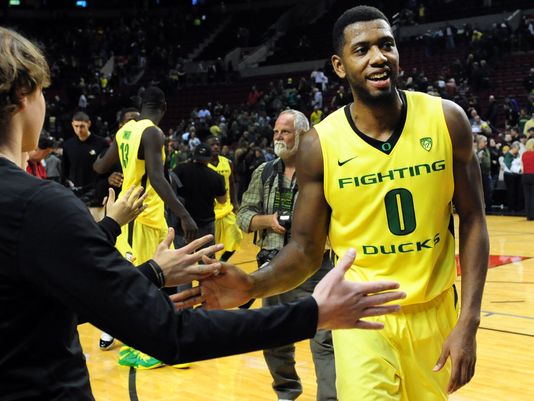Oregon Thrives on Offense, Dumps Illinois Despite Defensive Rebounding Struggles
Posted by Kenny Ocker on December 15th, 2013The Oregon Ducks have gotten off to their undefeated start in 2013-14 primarily on the strength of their staggeringly efficient offense. The Ducks ranked third in the nation in effective field goal percentage and were seventh in the nation in free throw rate before Saturday night’s game against Illinois at the former Rose Garden in Portland.
Aspects of Oregon’s defense are also strong, including a top-50 steal rate and a top-75 block rate. But one thing stands out in the Ducks’ statistical profile: a lack of proficiency on the defensive glass. Despite only playing one top-25 offensive rebounding team this season (San Francisco), Oregon ranks a pedestrian 235th in defensive rebounding rate. Against the Illini, that vulnerability showed up early – six offensive rebounds surrendered in the first half, which ended tied at 32 – and late, when they got a rebound putback from Joseph Bertrand to close the game within three points with less than a minute to go. But Oregon’s scoring was able to again cover for its defensive rebounding deficiency in a 71-64 win.
Oregon (9-0) certainly misses graduated senior transfer Arsalan Kazemi, who led the nation in defensive rebounding rate in 2012-13, but another senior transfer is attempting to fill that void. Mike Moser – a Portland native who previously played at both UCLA and UNLV – has led the Ducks on the defensive glass all season, including a team-high eight Saturday night, which also came with 14 points, tied for the team lead with fellow senior transfer Joseph Young. The performance of the 6’8” power forward Saturday is made more impressive when considering that Illinois’ starting frontcourt of Nnanna Egwu, Jon Ekey and Joseph Bertrand each gather eight percent or more of available offensive rebounds, and the Illini ranked 36th nationally in offensive rebound rate before the game.
Moser’s defensive rebounding rate of 20.9 percent in 2013-14 is a far cry from Kazemi’s 29.0 percent last season, but Moser’s supporting cast on the glass isn’t as gifted as Kazemi’s, with E.J. Singler and Carlos Emory having also departed Eugene. New starting center Waverly Austin is being outrebounded by shooting guard Damyean Dotson according to rebounding rate, for instance, as well as his backup, Richard Amardi, though Austin and Amardi are in a functional time share.
One thing that could shore up Oregon’s defensive rebounding is the return of suspended sophomore Ben Carter. The forward had a 15.3 percent defensive rebounding rate last year, which would put him third on the team now, not accounting for any improvement during the offseason; Carter sometimes looked physically unprepared for college basketball during his freshman year, so a year in the weight room could be huge for him. The return of fellow suspended sophomore Dominic Artis could give the Ducks an extra boost, as his 8.4 percent defensive rebounding rate last season would be better than any of Oregon’s current guards: Young, Johnathan Loyd, Jason Calliste or Jalil Abdul-Bassit. Artis’ ability to create turnovers defensively will also help protect Oregon’s big men inside, as fewer possessions end in shots.
Illinoid head coach John Groce (9-2) said after the game that he was impressed by Oregon’s offensive efficiency, noting its 25-of-37 performance from inside the three-point line. “At the end of the day, I’m not going to dissect this one. They’re a good team, a very good team,” Groce said. Oregon’s Dana Altman was a little bit less happy with how his team played, except for in the game’s final 10 minutes, in which it scored 26 points to Illinois’ 12. “We didn’t do a really good job on the boards that first 30 minutes, and defensively that game, the first 30 minutes showed just how far we have to go,” Altman said after the game. “We’ve got a long way to go with our defensive effort.”
Offensively, Oregon is having a special season. At this point, none of its nine most-used players is scoring less than a point per possession used, and three guards are in the top 50 nationally in efficiency: Young (12th), Calliste (44th), and Loyd (45th). Young and Loyd have achieved that high performance while each using more than 20 percent of available possessions, too; among players who use more than 20 percent of team possessions, the pair rank third and 12th in the nation in efficiency, respectively. Moser, Oregon’s other high-usage starter, also has a well-above-average efficiency that is overshadowed statistically, given the effectiveness of his teammates.
Though the nine-game suspensions of Carter and Artis have been exhausted, Altman said the pair will start their seasons on the bench and slowly work their ways into Oregon’s rotation. As the two get into game shape, a team rich in offense stands to get much richer defensively. With Oregon’s standout offense, that stands to make the Ducks a mighty opponent for the Pac-12, and a team to avoid when March comes.
(Author’s note: All unattributed season efficiency numbers, rebounding rates and national rankings are from KenPom.com and are taken from before Oregon’s game with Illinois on Saturday.)











































